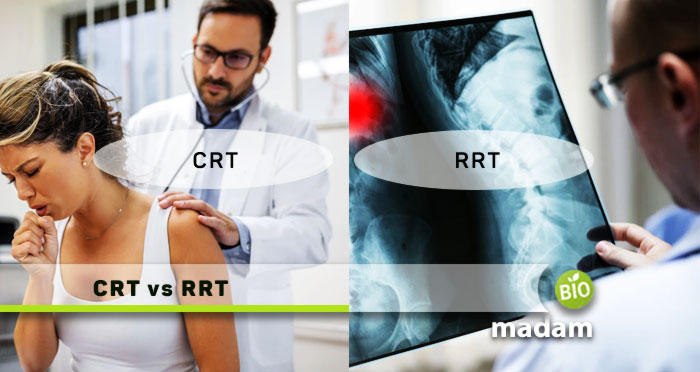Recently updated on February 15th, 2023 at 07:55 am
Medical professionals play an unmatched role in our lives, where physicians, pharmacists, PCTs, and CNAs work day and night to ensure proper healthcare for the patients. CRTs (certified respiratory therapists) and RRTs (registered respiratory therapists) are also important in diagnosing and treating respiratory diseases. While your physician may take your vitals using a type of stethoscope and sphygmomanometer, they may refer you to a CRT and RRT if they find suspicions. Both professionals contribute to the care of patients with respiratory issues, but still, the CRT and RRT are distinct from each other.
Keep reading to learn all the differences between CRT and RRT.
Comparison Table
| Characteristics | CRT | RRT |
| Backronym | Certified Respiratory Therapist | Registered Respiratory Therapist |
| Qualification Level | Bachelor’s, associate, or master’s degree | Graduate or associate degree from a respiratory therapy program |
| Education Courses | Therapeutics, biology, or pharmacology | Pathology, psychology, or pharmacology |
| Job Description | Help doctors diagnose, manage, & treat pulmonary disorders | Deal with patients with respiratory complications |
| Average Salary/Year | $56,848 | $82,000 |
What is CRT?
CRT or Certified Respiratory Therapists are health care professionals who associate with doctors to diagnose and treat patients facing difficulty breathing and suffering from pulmonary disorders. They play a major role in rehabilitating premature babies who cannot breathe properly. CRTs may be involved in collecting blood samples and conducting tests to diagnose of the condition. They also assist people with breathing problems due to trauma or accidents.
Certified respiratory therapists are the primary or entry-level professionals for respiratory issues. Generally, CRT’s credential represents a one-to-two-year educational program. It also describes the clinically trained program in each area of respiratory care at the initial level. Now, CRTs require a state license to practice in any healthcare facility.

Role of CRT
A Certified Respiratory Therapists (CRT) deals with the following conditions:
- Asthma & COPD
- Collapsed lungs
- Spinal muscular dystrophy
- Pneumonia
- Respiratory distress syndrome
- Chronic obstruct
What is RRT?
RRT or Registered Respiratory Therapists treat respiratory patients independently. They perform similar functions to CRTs but are more qualified and experienced. They possess different skills such as decision-making, clinical skills, training programs, etc. They also give consultation to patients based on their signs and symptoms.
RRTs are advanced credentials in their field. This credential is awarded to RRTs who clear the TMC and CSE tests. An RRT credential symbolizes the standard of excellence. RRTs are professional in their work as they are highly educated and certified.
Role of RRT
Registered Respiratory Therapists perform the following:
- Interaction with patients
- They diagnose respiratory problems
- They design treatment and care plans
- They conduct tests to check breathing patterns, its ability, lung capacity, and gas levels
- They observe the patient’s movements especially breathing style
- They operate mechanical ventilators machines

Differences Between a CRT and an RRT
Definition
CRT
CRTs are respiratory disease professionals with an entry-level certification provided by their university, followed by a state license.
RRT
While RRTs are advanced professionals who deal with respiratory diseases or lung disorders, and observe the prognosis to provide adequate treatment.
Backronym
CRT
CRT stands for Certified Respiratory Therapist.
RRT
At the same time, RRT is an acronym for Registered Respiratory Therapist.
Qualification Level
CRT
A CRT must be a graduate and should have the certificate of a bachelor’s, associate, or master’s degree from a respiratory therapy education program. After graduation, candidates apply for the “Therapist Multiple Choice (TMC) examination” to become certified therapists.
RRT
On the other hand, RRTs require a graduate-level or associate degree from an advanced-level respiratory therapy program accredited by the Commission on Accreditation for Respiratory Care (CoARC).
Education Courses
CRT
A CRT does not need a degree necessarily in respiratory therapy. So, they are flexible and can pursue any career of their choice. But to have an associate degree, CRT candidates must have a degree in therapeutics, pharmacology, or any relevant branch of biology.
RRT
Whereas an RRT needs to have a degree in respiratory therapy. This degree can be of any level of education: bachelor’s degree, master’s degree, or associate degree. The higher level of education will be, the more opportunities for jobs there will be. The degree for RRT has courses like pathology, psychology, pharmacology, etc. RRTs must be CRTs for at least four years before applying for an RRT.
Job Description
CRT
Certified Respiratory Therapists help doctors diagnose, manage, and treat pulmonary disorders. They collect blood samples and breath specimens to analyze the patient’s condition.
RRT
Conversely, the job of RRTs is more directly associated with patients with pulmonary complications. They also perform tests like CT scans and X-rays to assess the functioning of the right or left lung and respiratory system of the patient.
Salary
CRT
CRTs earn between $41k and $90 per year in the US. They make $56,848 on average annually or $35 per hour.
RRT
In contrast, the salary of an RRT is quite higher than CRT. It ranged from $33 to $37 per hour. They earn around $82,000 in the US per year on average.
How to Advance from a CRT to RRT?
Most professionals who opt to become CRTs look forward to being an RRT in the future. The reason is high job security and better salaries than CRTs. While you might want to rush to become an RRT, you will need to wait for at least four years. CRTs are eligible for the RRT exam after four years of being a CRT when they have 62 semester hours of college accredited by the regional association or its equivalent. Alternatively, applicants with a baccalaureate degree or an associate degree from an entry-level respiratory care education program can apply after two years of obtaining CRT certification. However, you must have completed 62 semester hours of college credit in microbiology, chemistry, mathematics, anatomy, and physiology.
The Bottom Line
CRTs and RRTs are respiratory disease professionals who evaluate and treat respiratory conditions in patients complaining of breathing difficulties. They help the patients with some breathing exercises, and also play a critical role in assisting premature babies with underdeveloped lungs till their lungs develop properly. Respiratory professionals also attend to bronchitis, asthma, or COPD patients requiring in-depth professional intervention. Despite the similarities, the main difference between CRT and RRT is their qualification and experience. CRTs are entry-level respiratory professionals, while RRTs are at least two years more experienced than CRTs.
FAQs
What is the highest degree for respiratory therapist?
Respiratory therapists can obtain a master’s degree from respiratory therapy education programs accredited by the Commission on Accreditation for Respiratory Care (CoARC). Nevertheless, they can obtain a certification with an associate’s or bachelor’s degree.
Is respiratory therapy harder than nursing?
Surveys show that medical professionals who have studied both programs believe nursing is harder than respiratory therapy. However, it is not always the same for everyone. You might find nursing easier if you have a keen interest in it.
Can RRT intubate?
Yes, registered respiratory therapists can perform endotracheal intubation, as supported by the literature. Many RRTs perform this procedure in hospitals, given that they have the skill and adequate training.

Hi, my name is Eva. I am currently practicing as a clinical social worker, that being my childhood desire. As a licensed therapist holding MPhil in Clinical Psychology, I am now on biomadam to provide the natives with the best family advice! Do you have any questions? See you in the comment section.

